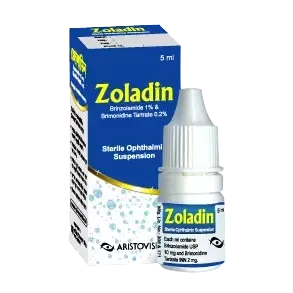
✔ 100% Authentic Product
👁️ Currently Viewing 2034
Zoladin Eye Drop (1%+0.2%)
Zoladin (Brinzolamide + Brimonidine Tartrate0 5ml Eye Drop is a prescription medication containing a combination of two active ingredients: Brinzolamide and Brimonidine. It is primarily used for the treatment of glaucoma and ocular hypertension. This combination helps reduce elevated pressure within the eye (intraocular pressure or IOP) by decreasing the production of aqueous humor and increasing its drainage. By lowering the pressure, Zoladin minimizes the risk of optic nerve damage and vision loss.
Discount
Price: ৳ 665
MRP:
৳
700
5%
Off

100% Genuine Products, Guaranteed

Safe & Secure Payments, Always

Fast, Secure & Efficient Delivery

Proper Packaging
 Cash on Delivery - All over Bangladesh
Cash on Delivery - All over Bangladesh Regular Delivery - 12-24 Hours, Dhaka City* Charge Tk.39-59
Regular Delivery - 12-24 Hours, Dhaka City* Charge Tk.39-59 Regular Delivery - 24-48 Hours, Other Cities* Charge Tk.99-110
Regular Delivery - 24-48 Hours, Other Cities* Charge Tk.99-110
 ফ্রি ডেলিভারিঃ - ৯৯৯ টাকা+ অর্ডারে, ঢাকা
শহরে
ফ্রি ডেলিভারিঃ - ৯৯৯ টাকা+ অর্ডারে, ঢাকা
শহরে ফ্রি ডেলিভারিঃ - ২৯৯৯ টাকা+ অর্ডারে, ঢাকার
বাহিরে
ফ্রি ডেলিভারিঃ - ২৯৯৯ টাকা+ অর্ডারে, ঢাকার
বাহিরে
100% Genuine Products, Guaranteed
Safe & Secure Payments, Always
Fast, Secure & Efficient Delivery
Proper Packaging
 Cash on Delivery - All over Bangladesh
Cash on Delivery - All over Bangladesh Regular Delivery - 12-24 Hours, Dhaka City* Charge Tk.39-59
Regular Delivery - 12-24 Hours, Dhaka City* Charge Tk.39-59 Regular Delivery - 24-48 Hours, Other Cities* Charge Tk.99-110
Regular Delivery - 24-48 Hours, Other Cities* Charge Tk.99-110 ফ্রি ডেলিভারিঃ - ৯৯৯ টাকা+ অর্ডারে, ঢাকা
শহরে
ফ্রি ডেলিভারিঃ - ৯৯৯ টাকা+ অর্ডারে, ঢাকা
শহরে ফ্রি ডেলিভারিঃ - ২৯৯৯ টাকা+ অর্ডারে, ঢাকার
বাহিরে
ফ্রি ডেলিভারিঃ - ২৯৯৯ টাকা+ অর্ডারে, ঢাকার
বাহিরে
✅ Description:

✔️ How Zoladin Works
- Brinzolamide:
A carbonic anhydrase inhibitor that reduces aqueous humor secretion by inhibiting carbonic anhydrase enzymes in the ciliary processes of the eye. This results in a decrease in intraocular pressure. - Brimonidine:
An alpha-2 adrenergic receptor agonist that reduces IOP through two mechanisms: decreasing aqueous humor production and enhancing uveoscleral outflow.
Together, these mechanisms provide effective control over elevated eye pressure.
✔️ Key Tips for Effective Use
- Apply gentle pressure to the inner corner of the eye (near the nose) for about 1 minute after applying the drop. This prevents the medication from draining into the tear ducts.
- Avoid touching the dropper tip to your eye or any surface to minimize the risk of contamination.
- If more than one ophthalmic medication is prescribed, ensure a time gap of 5-10 minutes between their applications.
- Consult your doctor immediately if you experience prolonged irritation, severe allergic reactions, or if the medication accidentally enters your mouth, nose, or ears.
✔️ Side Effects of Zoladin Sterile Eye Drop
Common Side Effects:
- Eye-related:
- Irritation, burning, or stinging sensation
- Blurred vision
- Eye redness
- Foreign body sensation
- Dryness
- Systemic:
- Headache
- Fatigue or drowsiness
- Dry mouth
- Altered taste (dysgeusia)
Rare Side Effects:
- Eye Pain
- Conjunctivitis or discharge
- Corneal erosion or photophobia
- Systemic:
- Dizziness
- Hypertension
- Gastrointestinal discomfort
- Palpitations
✔️ How to Use Zoladin
- Zoladin is intended for external use only. Instill the prescribed number of drops into the affected eye(s) as per your doctor’s instructions.
- Wash your hands thoroughly before using the drops.
- Hold the dropper close to your eye without touching it to avoid contamination.
- Squeeze the dropper gently and place the medication inside the lower eyelid. Wipe off any excess liquid with a clean tissue.
- If using multiple ophthalmic medications, wait at least 5-10 minutes between applications to prevent dilution.
Shake the bottle well before each use to ensure the uniformity of the medication.
If you wear soft contact lenses, remove them before applying the eye drops and wait for at least 15 minutes before reinserting them.
✔️ Dosage Guidelines
- Adults:
Instill one drop into the affected eye(s) 2-3 times daily, or as directed by your physician. - Children:
- Under 2 years: Not recommended, as safety and efficacy have not been established.
- Above 2 years: The same dosage as adults (1 drop, 2-3 times daily).
Do not skip doses, and complete the entire prescribed course even if symptoms improve. Discontinuing treatment prematurely may cause symptoms to return or worsen.
✔️ Drug Interactions:
Brinzolamide may interact with oral carbonic anhydrase inhibitors or high-dose salicylates, increasing the risk of toxicity.
Brimonidine may potentiate the effects of CNS depressants like alcohol, barbiturates, or sedatives. Use cautiously with other medications like beta-blockers, antihypertensives, or cardiac glycosides.
✔️ Precautions and Warnings
- Use with caution, especially in patients with severe liver or kidney problems, as Brinzolamide is primarily excreted through the kidneys.
- Classified as Pregnancy Category C: Use during pregnancy only if the potential benefit outweighs the risk.
- Unknown whether it is excreted in human breast milk; therefore, breastfeeding is not recommended during treatment.
Zoladin may cause temporary blurred vision or drowsiness. Avoid activities requiring alertness (e.g., driving or operating heavy machinery) immediately after using the drops. - The preservative in Zoladin, benzalkonium chloride, can be absorbed by soft contact lenses. Wait at least 15 minutes after installation before reinserting lenses.
Avoid using Zoladin if you are allergic to Brinzolamide, Brimonidine, or any other component in the formulation.
✔️ Storage:
- Store the bottle at room temperature, away from direct light and moisture.
- Do not freeze the medication.
- Once opened, use the drops within 4 weeks to avoid contamination.
⚠️Disclaimer:
At ePharma, we’re committed to providing accurate and accessible health information. However, all content is intended for informational purposes only and should not replace medical advice from a qualified physician. Please consult your healthcare provider for personalized guidance. We aim to support, not substitute, the doctor-patient relationship.









